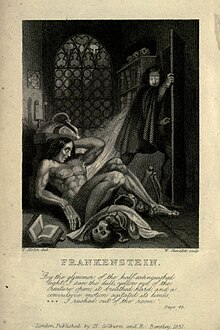 Global Information
Global InformationGothic aspects in Frankenstein information

When Mary Shelley's Frankenstein was published in 1818, the novel immediately found itself labeled as Gothic and, with a few exceptions, promoted to the status of masterpiece.
The Gothic wave began with Horace Walpole's The Castle of Otranto (1764), followed by aristocrat William Beckford's Vathek (1787),[1] and peaked with the works of Ann Radcliffe (1791-1797). After a few spurts with The Monk by Lewis (1796), it has since been in marked decline. After that, the novel moved on to something else, becoming historical with Walter Scott, and later truly romantic with the Brontë sisters. The Gothic did, however, persist within the Victorian novel, particularly in Wilkie Collins and Charles Dickens, but only as a hint.[2]
Before 1818, or at the time of Frankenstein's composition, the genre was considered in bad taste, if not downright laughable. In accordance with Edmund Burke's warnings,[3] the line between the fantastique and the ridiculous seemed to have been crossed. Coleridge, familiar with the Godwins and thus with Mary Shelley, wrote as early as 1797, in reference to M. G. Lewis's The Monk, that "the horrible and the supernatural [...], powerful stimulants, are never required, unless for the torpor of a drowsy or exhausted appetite". He criticized "tiresome enemies, insubstantial characters, screams, murders, subterranean dungeons, [...] imagination and thought out of breath, [...] vulgar and low taste."[4] In Northanger Abbey, Jane Austen, in 1817, had Henry Tilney give Catherine Morland a lesson in common sense:[5] "Remember that we are English, that we are Christian. Appeal to your understanding, your appreciation of verisimilitude, your sense of observation [...] does your education prepare you for similar atrocities?"[6] In other words, the critics embraced the Incredulus odi,[7] which led to an overdose of the marvelous, whose very nature, as Walter Scott pointed out in 1818, is to be "easily exhausted.[8]
Frankenstein's immediate and undeniable success was based on foundations that differed from those of its predecessors, if not in appearance, then at least in essence. The novel substitutes horror for terror, divests itself of all wonder, favors internalization and anchors itself in rationality, to the point where its gothic style becomes almost realistic and has revelatory value.
- ^ Duperray (1994, p. 39)
- ^ Duperray (1994, pp. 38–39)
- ^ Edmund Burke, A Philosophical Enquiry into the Origin of Our Ideas of the Sublime and Beautiful, 1757.
- ^ Coleridge, Samuel Taylor (19 February 1797). Compte rendu de Le Moine de Matthew Gregory Lewis (in French). Critical Review. pp. 194–200.
- ^ Seeber, Barbara Karolina (2000). General consent in Jane Austen : a study of dialogism. McGill-Queen's University Press. ISBN 978-0-7735-2066-0.
- ^ Austen, Jane. "Northanger Abbey, Chapter 24". fr. Retrieved April 26, 2013.
- ^ Horace, Ars Poetica, Ar, translated by C. Lefebvre-Laroche, Paris, P. Didot l'aîné, 1798, c. 188, p. 22.
- ^ Coleridge, Samuel Taylor (1827). "On the Supernatural in Literary Composition; and Particularly on the Works of Ernest Theodore William Hoffman" (PDF). Foreign Quarterly Review. 1 (1). Retrieved April 26, 2013.